Diatom Frustule Array for Flow-Through Enhancement of Fluorescent Signal in a Microfluidic Chip
Abstract
:1. Introduction
2. Materials and Methods
2.1. Materials and Characterization
2.2. Fabrication of Si Substrate with Step-Through Holes
2.3. Coating Hot-Melt Glue in Micro-Holes under Capillary Force and Bonding Frustules
2.4. Patterning Frustules by a Micromanipulator
2.5. Modification of Diatom Frustules and Antigen–Antibody Test
2.6. PMMA Microfluidic Chip Fabrication and Bonding
3. Results and Discussion
3.1. Diatom Frustule Morphology and Array
3.2. Diatom Modified Process and POCT Devices
3.3. User Interface and Working Principle
3.4. Capture Performance of Flow-Through vs. Flow-Over Test
3.5. Adsorption Simulation
4. Conclusions
Supplementary Materials
Author Contributions
Funding
Conflicts of Interest
References
- Hamm, C.E.; Merkel, R.; Springer, O.; Jurkojc, P.; Maiert, C.; Prechtelt, K.; Smetacek, V. Architecture and material properties of diatom shells provide effective mechanical protection. Nature 2003, 421, 841–843. [Google Scholar] [CrossRef] [Green Version]
- Wang, Y.; Zhang, D.; Pan, J.; Cai, J. Key factors influencing the optical detection of biomolecules by their evaporative assembly on diatom frustules. J. Mater. Sci. 2012, 47, 6315–6325. [Google Scholar] [CrossRef]
- Yang, J.; Zhen, L.; Ren, F.; Campbell, J.; Rorrer, G.L.; Wang, A.X. Ultra-sensitive immunoassay biosensors using hybrid plasmonic-biosilica nanostructured materials. J. Biophotonics 2015, 8, 659–667. [Google Scholar] [CrossRef] [PubMed]
- Wee, K.M.; Rogers, T.N.; Altan, B.S.; Hackney, S.A.; Hamm, C. Engineering and medical applications of diatoms. J. Nanosci. Nanotechnol. 2005, 5, 88–91. [Google Scholar] [CrossRef] [PubMed]
- De Stefano, L.; Larnberti, A.; Rotiroti, L.; De Stefano, M. Interfacing the nanostructured biosilica microshells of the marine diatom Coscinodiscus wailesii with biological matter. Acta Biomater. 2008, 4, 126–130. [Google Scholar] [CrossRef] [PubMed]
- Aw, M.S.; Simovic, S.; Yu, Y.; Addai-Mensah, J.; Losic, D. Porous silica microshells from diatoms as biocarrier for drug delivery applications. Powder Technol. 2012, 223, 52–58. [Google Scholar] [CrossRef]
- Kong, X.; Squire, K.; Leduff, P.; Rorrer, G.L.; Wang, A.X. Ieee Dual-Mode Immunoassay using Photonic Crystal Biosilica. In Proceedings of the Conference on Lasers and Electro-Optics (CLEO), San Jose, CA, USA, 14–19 May 2017. [Google Scholar]
- Li, Z.; Zhang, N.; Sun, Y.; Ke, H.; Cheng, H. Application of diatomite as an effective polysulfides adsorbent for lithium-sulfur batteries. J. Energy Chem. 2017, 26, 1267–1275. [Google Scholar] [CrossRef] [Green Version]
- Townley, H.E.; Woon, K.L.; Payne, F.P.; White-Cooper, H.; Parker, A.R. Modification of the physical and optical properties of the frustule of the diatom Coscinodiscus wailesii by nickel sulfate. Nanotechnology 2007, 18, 295101. [Google Scholar] [CrossRef]
- Guo, D.; Wang, H.; Fu, P.; Huang, Y.; Liu, Y.; Lv, W.; Wang, F. Diatomite precoat filtration for wastewater treatment: Filtration performance and pollution mechanisms. Chem. Eng. Res. Des. 2018, 137, 403–411. [Google Scholar] [CrossRef]
- Losic, D.; Rosengarten, G.; Mitchell, J.G.; Voelcker, N.H. Pore architecture of diatom frustules: Potential nanostructured membranes for molecular and particle separations. J. Nanosci. Nanotechnol. 2006, 6, 982–989. [Google Scholar] [CrossRef]
- Losic, D.; Yu, Y.; Aw, M.S.; Simovic, S.; Thierry, B.; Addai-Mensah, J. Surface functionalisation of diatoms with dopamine modified iron-oxide nanoparticles: Toward magnetically guided drug microcarriers with biologically derived morphologies. Chem. Commun. 2010, 46, 6323–6325. [Google Scholar] [CrossRef]
- Lettieri, S.; Setaro, A.; De Stefano, L.; De Stefano, M.; Maddalena, P. The gas-detection properties of light-emitting diatoms. Adv. Funct. Mater. 2008, 18, 1257–1264. [Google Scholar] [CrossRef]
- Jeffryes, C.; Gutu, T.; Jiao, J.; Rorrer, G.L. Metabolic Insertion of Nanostructured TiO2 into the Patterned Biosilica of the Diatom Pinnularia sp by a Two-Stage Bioreactor Cultivation Process. ACS Nano 2008, 2, 2103–2112. [Google Scholar] [CrossRef]
- Delalat, B.; Sheppard, V.C.; Rasi Ghaemi, S.; Rao, S.; Prestidge, C.A.; McPhee, G.; Rogers, M.-L.; Donoghue, J.F.; Pillay, V.; Johns, T.G.; et al. Targeted drug delivery using genetically engineered diatom biosilica. Nat. Commun. 2015, 6, 8791. [Google Scholar] [CrossRef] [PubMed] [Green Version]
- Chandrasekaran, S.; Macdonald, T.J.; Gerson, A.R.; Nann, T.; Voelcker, N.H. Boron-Doped Silicon Diatom Frustules as a Photocathode for Water Splitting. ACS Appl. Mater. Interfaces 2015, 7, 17381–17387. [Google Scholar] [CrossRef] [PubMed]
- Li, K.; Feng, S.; Jing, C.; Chen, Y.; Liu, X.; Zhang, Y.; Zhou, L. Assembling a double shell on a diatomite skeleton ternary complex with conductive polypyrrole for the enhancement of supercapacitors. Chem. Commun. 2019, 55, 13773–13776. [Google Scholar] [CrossRef] [PubMed]
- Zhang, H.; Shahbazi, M.-A.; Makila, E.M.; da Silva, T.H.; Reis, R.L.; Salonen, J.J.; Hirvonen, J.T.; Santos, H.A. Diatom silica microparticles for sustained release and permeation enhancement following oral delivery of prednisone and mesalamine. Biomaterials 2013, 34, 9210–9219. [Google Scholar] [CrossRef] [PubMed]
- Wang, Z.; Cai, J.; Jiang, Y.; Zhang, D. Harnessing a droplet to orient and assemble diatom frustules. J. Micromech. Microeng. 2019, 29, 095007. [Google Scholar] [CrossRef]
- Kong, X.M.; Chong, X.Y.; Squire, K.; Wang, A.X. Microfluidic diatomite analytical devices for illicit drug sensing with ppb-Level sensitivity. Sens. Actuators B Chem. 2018, 259, 587–595. [Google Scholar] [CrossRef]
- Wang, Y.; Pan, J.; Cai, J.; Zhang, D. Floating assembly of diatom Coscinodiscus sp. microshells. Biochem. Biophys. Res. Commun. 2012, 420, 1–5. [Google Scholar] [CrossRef] [PubMed]
- Cai, J.; Wang, X.; Li, A.; Anderson, S.W.; Zhang, X. Biologically enabled micro- and nanostencil lithography using diatoms. Extrem. Mech. Lett. 2015, 4, 186–192. [Google Scholar] [CrossRef] [Green Version]
- Li, A.; Zhang, W.; Ghaffarivardavagh, R.; Wang, X.; Anderson, S.W.; Zhang, X. Towards uniformly oriented diatom frustule monolayers: Experimental and theoretical analyses. Microsyst. Nanoeng. 2016, 2, 16064. [Google Scholar] [CrossRef] [PubMed] [Green Version]
- Wang, W.; Gutu, T.; Gale, D.K.; Jiao, J.; Rorrer, G.L.; Chang, C. Self-Assembly of Nanostructured Diatom Microshells into Patterned Arrays Assisted by Polyelectrolyte Multilayer Deposition and Inkjet Printing. J. Am. Chem. Soc. 2009, 131, 4178–4179. [Google Scholar] [CrossRef]
- Wang, Y.; Pan, J.; Cai, J.; Li, A.; Chen, M.; Zhang, D. Assembling and Patterning of Diatom Frustules onto PDMS Substrates Using Photoassisted Chemical Bonding. Chem. Lett. 2011, 40, 1354–1356. [Google Scholar] [CrossRef]
- Li, A.; Cai, J.; Pan, J.; Wang, Y.; Yue, Y.; Zhang, D. Multi-layer hierarchical array fabricated with diatom frustules for highly sensitive bio-detection applications. J. Micromech. Microeng. 2014, 24, 025014. [Google Scholar] [CrossRef]
- Cai, J.; Wang, Z.; Wang, M.; Zhang, D. Au nanoparticle-grafted hierarchical pillars array replicated from diatom as reliable SERS substrates. Appl. Surf. Sci. 2021, 541, 148374. [Google Scholar] [CrossRef]
- Pan, J.F.; Wang, Y.; Cai, J.; Li, A.B.; Zhang, H.Y.; Jiang, Y.G.; Zhang, D.Y. Bonding of diatom frustules and Si substrates assisted by hydrofluoric acid. New J. Chem. 2014, 38, 206–212. [Google Scholar] [CrossRef]
- Yu, Y.; Addai-Mensah, J.; Losic, D. Functionalized diatom silica microparticles for removal of mercury ions. Sci. Technol. Adv. Mater. 2012, 13. [Google Scholar] [CrossRef] [Green Version]
- Qi, Y.; Wang, J.; Wang, X.; Cheng, J.J.; Wen, Z. Selective adsorption of Pb(II) from aqueous solution using porous biosilica extracted from marine diatom biomass: Properties and mechanism. Appl. Surf. Sci. 2017, 396, 965–977. [Google Scholar] [CrossRef]
- Marella, T.K.; Saxena, A.; Tiwari, A. Diatom mediated heavy metal remediation: A review. Bioresour. Technol. 2020, 305, 123068. [Google Scholar] [CrossRef] [PubMed]
- Kong, X.; Xi, Y.; Le Duff, P.; Chong, X.; Li, E.; Ren, F.; Rorrer, G.L.; Wang, A.X. Detecting explosive molecules from nanoliter solution: A new paradigm of SERS sensing on hydrophilic photonic crystal biosilica. Biosens. Bioelectron. 2017, 88, 63–70. [Google Scholar] [CrossRef] [Green Version]
- De Stefano, L.; Rotiroti, L.; De Stefano, M.; Lamberti, A.; Lettieri, S.; Setaro, A.; Maddalena, P. Marine diatoms as optical biosensors. Biosens. Bioelectron. 2009, 24, 1580–1584. [Google Scholar] [CrossRef] [PubMed]
- Jenie, S.N.A.; Plush, S.E.; Voelcker, N.H. Recent Advances on Luminescent Enhancement-Based Porous Silicon Biosensors. Pharm. Res. 2016, 33, 2314–2336. [Google Scholar] [CrossRef] [PubMed]
- Otsu, N. Threshold Selection Method from Gray-Level Histograms, IEEE Transactions on Systems Man and Cybernetics. IEEE Trans. Syst. Man Cybern. 1979, 9, 62–66. [Google Scholar] [CrossRef] [Green Version]
- Martin-Sanchez, D.; Ponce-Alcantara, S.; Garcia-Ruperez, J. Sensitivity Comparison of a Self-Standing Porous Silicon Membrane Under Flow-Through and Flow-Over Conditions. IEEE Sens. J. 2019, 19, 3276–3281. [Google Scholar] [CrossRef]
- Bettotti, P.; Kumar, N.; Guider, R.; Froner, E.; Scarpa, M. Role of nonspecific binding: A comparison among flow through and flow over assays in nanoporous material. In Proceedings of the Conference on Nanoscale Imaging Sensing, and Actuation for Biomedical Applications XI, San Francisco, CA, USA, 3–6 February 2014; Volume 8954. [Google Scholar]
- Escobedo, C.; Brolo, A.G.; Gordon, R.; Sinton, D. Flow-Through vs Flow-Over: Analysis of Transport and Binding in Nanohole Array Plasmonic Biosensors. Anal. Chem. 2010, 82, 10015–10020. [Google Scholar] [CrossRef] [PubMed]
- Zhao, Y.; Gaur, G.; Retterer, S.T.; Laibinis, P.E.; Weiss, S.M. Flow-through porous silicon membranes for real-time label-free biosensing. Anal. Chem. 2016, 88, 10940–10948. [Google Scholar] [CrossRef] [Green Version]
- De la Escosura-Muniz, A.; Merkoci, A. Nanochannels Preparation and Application in Biosensing. ACS Nano 2012, 6, 7556–7583. [Google Scholar] [CrossRef] [PubMed]
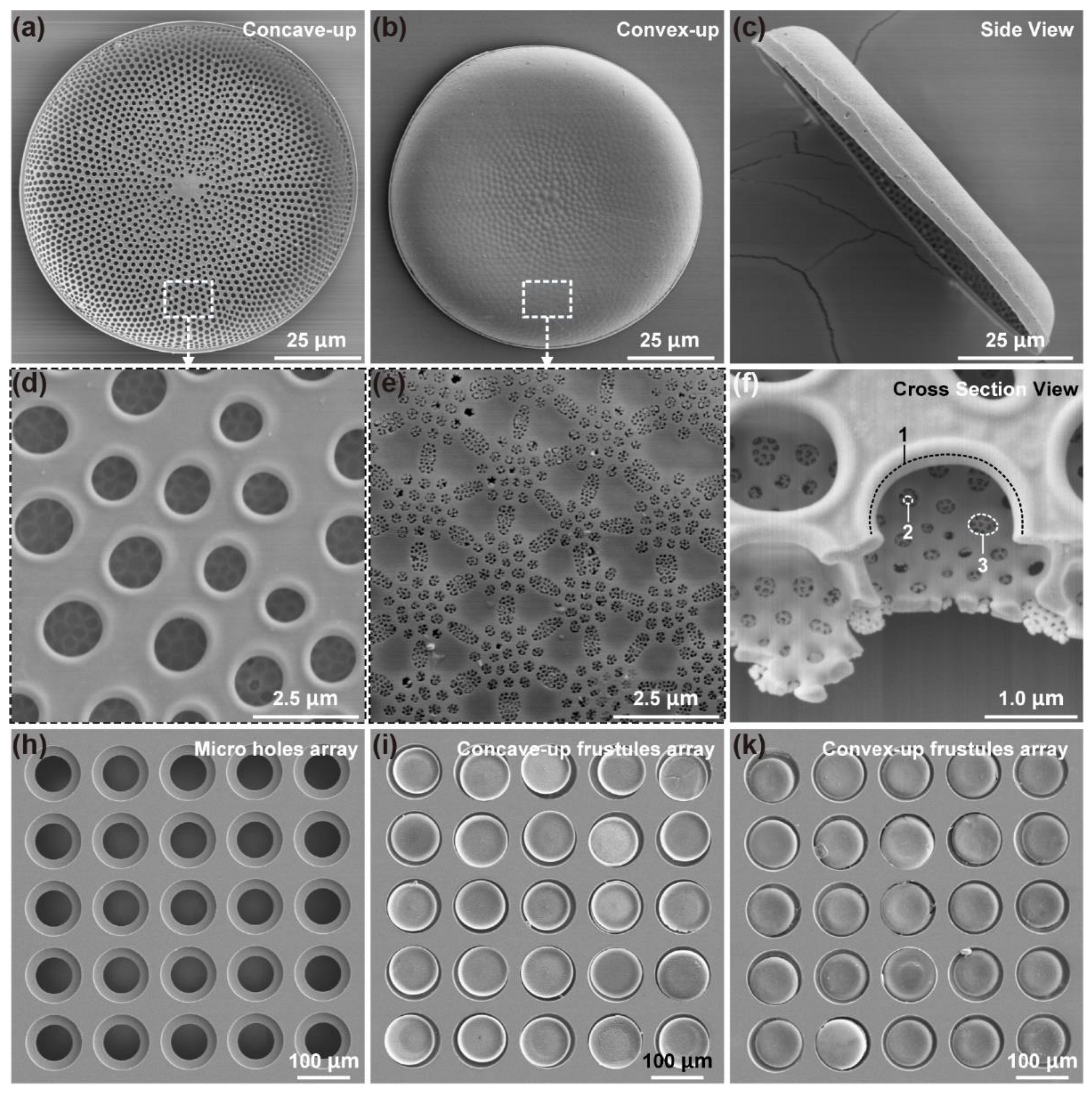
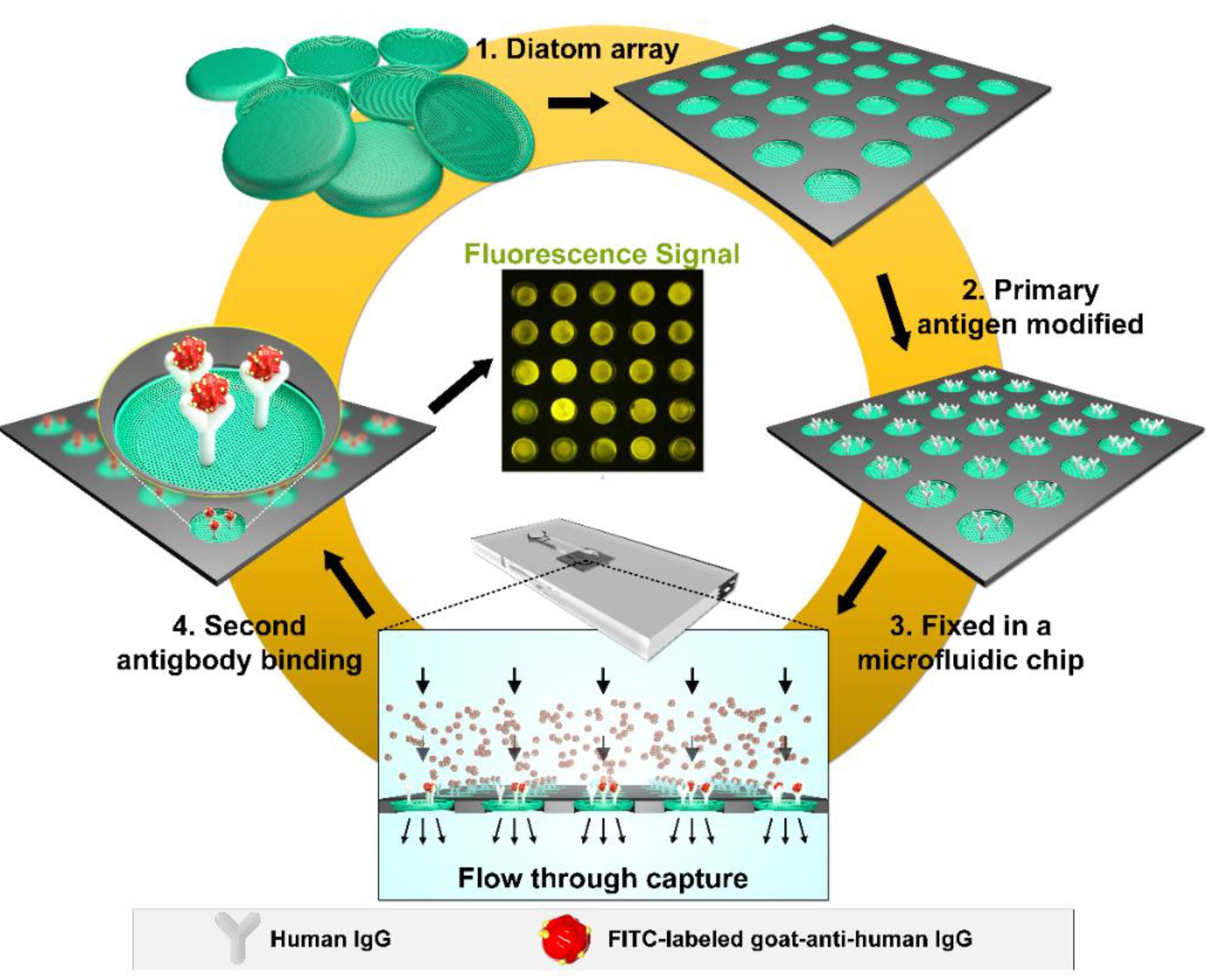
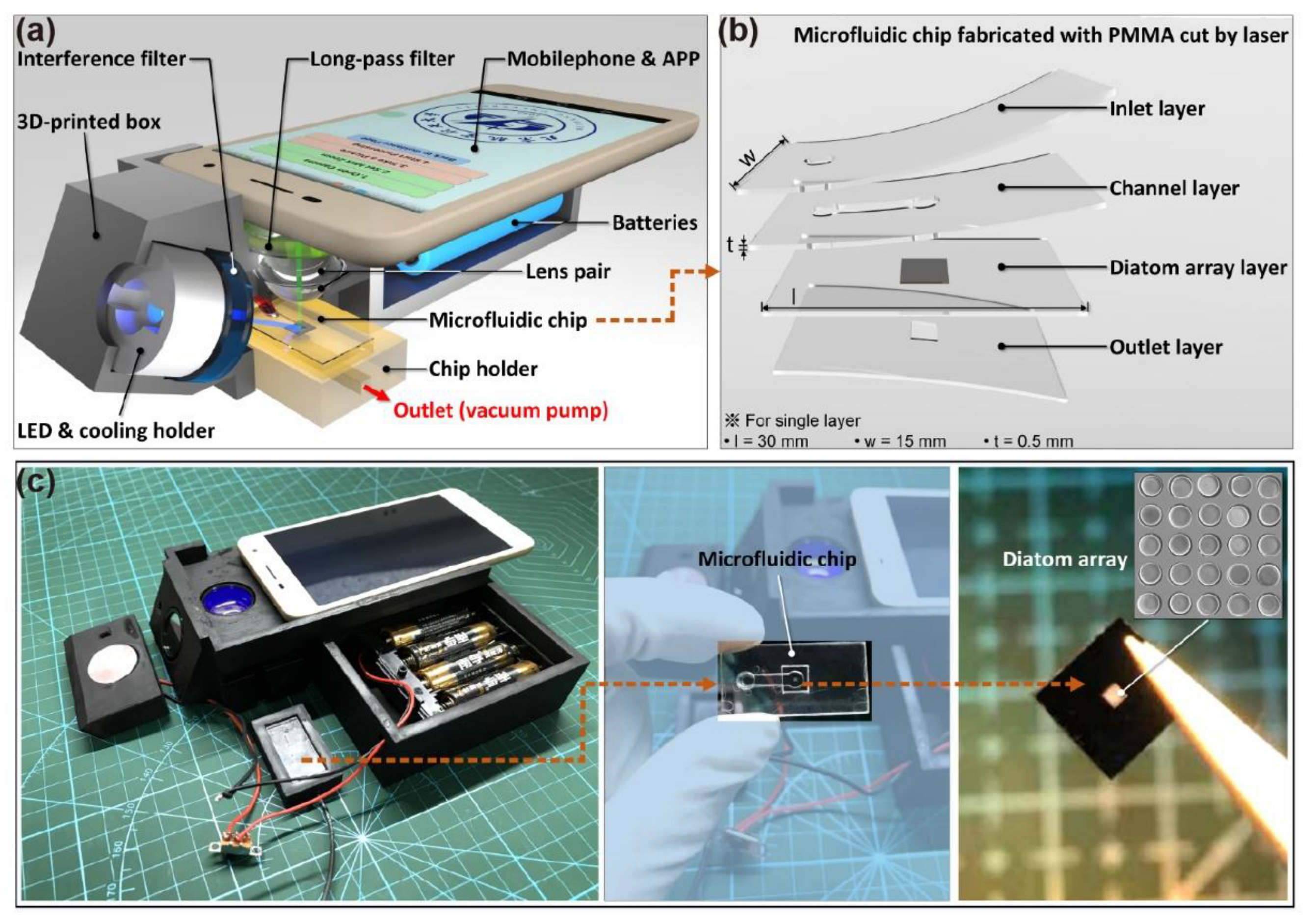
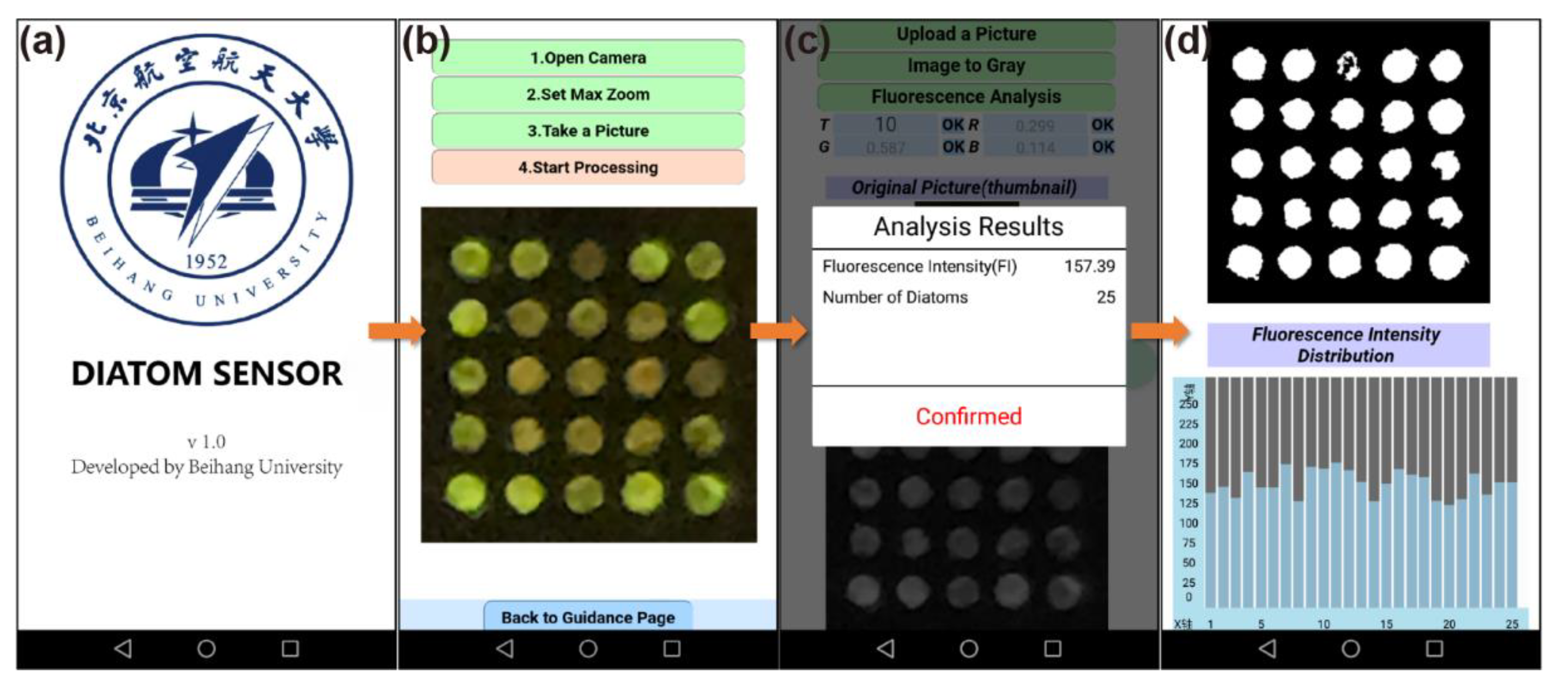


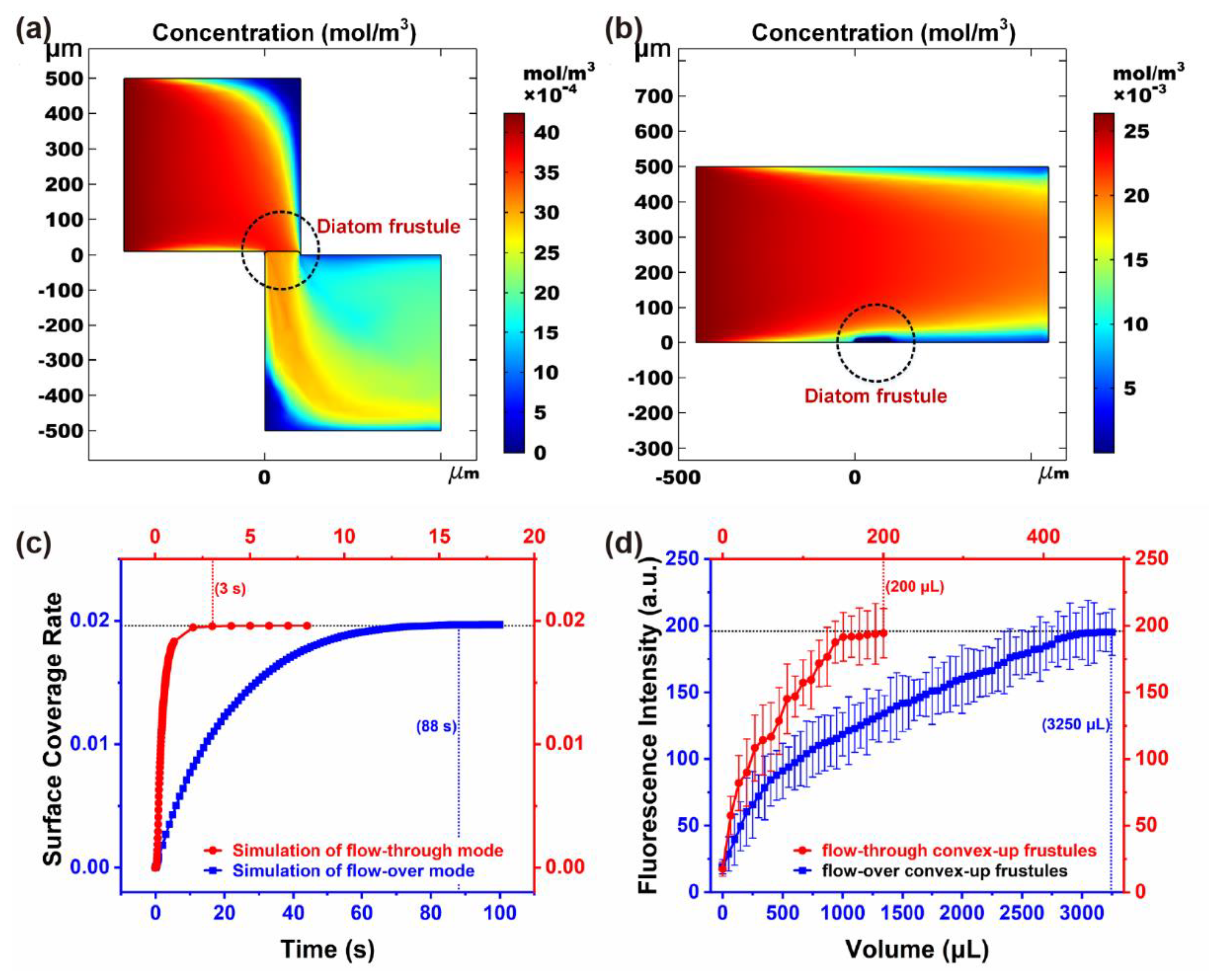
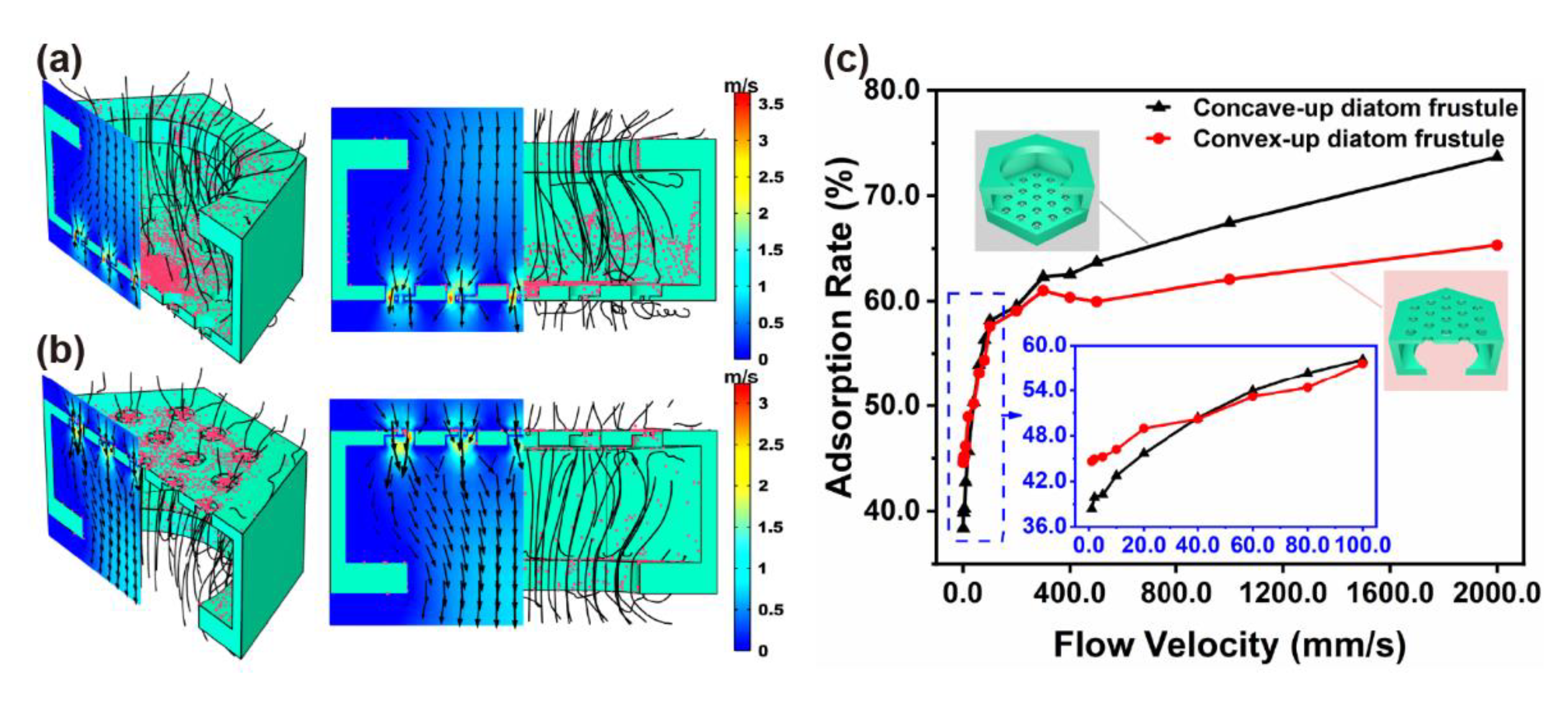
Publisher’s Note: MDPI stays neutral with regard to jurisdictional claims in published maps and institutional affiliations. |
© 2021 by the authors. Licensee MDPI, Basel, Switzerland. This article is an open access article distributed under the terms and conditions of the Creative Commons Attribution (CC BY) license (https://creativecommons.org/licenses/by/4.0/).
Share and Cite
Wang, Z.; Gong, D.; Cai, J. Diatom Frustule Array for Flow-Through Enhancement of Fluorescent Signal in a Microfluidic Chip. Micromachines 2021, 12, 1017. https://doi.org/10.3390/mi12091017
Wang Z, Gong D, Cai J. Diatom Frustule Array for Flow-Through Enhancement of Fluorescent Signal in a Microfluidic Chip. Micromachines. 2021; 12(9):1017. https://doi.org/10.3390/mi12091017
Chicago/Turabian StyleWang, Zhenhu, De Gong, and Jun Cai. 2021. "Diatom Frustule Array for Flow-Through Enhancement of Fluorescent Signal in a Microfluidic Chip" Micromachines 12, no. 9: 1017. https://doi.org/10.3390/mi12091017
APA StyleWang, Z., Gong, D., & Cai, J. (2021). Diatom Frustule Array for Flow-Through Enhancement of Fluorescent Signal in a Microfluidic Chip. Micromachines, 12(9), 1017. https://doi.org/10.3390/mi12091017






